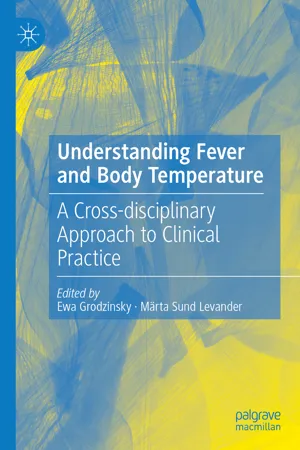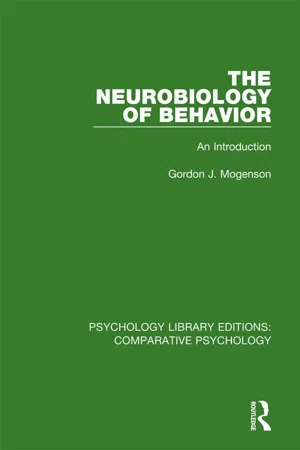Biological Sciences
Body Temperature Regulation
Body temperature regulation is the process by which the body maintains a stable internal temperature despite external fluctuations. This is achieved through a combination of physiological and behavioral mechanisms, such as shivering to generate heat or sweating to cool down. The hypothalamus in the brain plays a central role in coordinating these responses to ensure the body's temperature remains within a narrow range.
Written by Perlego with AI-assistance
Related key terms
6 Key excerpts on "Body Temperature Regulation"
- eBook - ePub
Understanding Fever and Body Temperature
A Cross-disciplinary Approach to Clinical Practice
- Ewa Grodzinsky, Märta Sund Levander, Ewa Grodzinsky, Märta Sund Levander(Authors)
- 2019(Publication Date)
- Palgrave Macmillan(Publisher)
© The Author(s) 2020Begin AbstractE. Grodzinsky, M. Sund Levander (eds.)Understanding Fever and Body Temperature https://doi.org/10.1007/978-3-030-21886-7_55. Thermoregulation of the Human Body
End AbstractEwa Grodzinsky1andMärta Sund Levander2(1) Department of Pharmaceutic Research, Linköping University, Linköping, Sweden(2) Department of Nursing, Linköping University, Linköping, SwedenEwa Grodzinsky (Corresponding author)The body is an open system that needs to protect its internal environment from its surroundings. At the same time it is dependent on its surroundings for the exchange of oxygen, nutrients, waste products, and heat. These conflicting demands need particularly physiological mechanisms to maintain a stable and balanced internal environment, so-called homeostasis . The complex physiological self-regulatory mechanisms and processes required to achieve homeostasis are maintained by specialized organs and organ systems in the body. The ability to regulate and exchange body heat is essential for survival in humans. Regulation of body temperature operates via a neural feedback system . Sensory inflows indicating cold or heat from several different parts of the body, such as the skin and internal organs, reach specialized neurons located in the central nervous system, chiefly in the hypothalamus . The hypothalamus integrates the incoming sensory information and transmits neural and hormonal signals, initiating various kinds of physiological activity . The physiological activities represent, in broad terms, heat gain , or, alternatively, heat loss , and thus maintain an appropriate body temperature . Organs or organ systems besides the nervous system that are the main actors in regulation of body temperature are the cardiovascular system , the sudomotor control system, and skeletal muscles . These systems ensure that the rate of heat loss is balanced by the amount of heat gain so as to ensure an appropriate body temperature . Body temperature is regulated between fairly narrow limits: 35 °C (95 °F) to 41 °C (105.8 °F) [1 ]. An immoderate rise in body temperature (hyperthermia - eBook - ePub
The Neurobiology of Behavior
An Introduction
- Gordon J. Mogenson(Author)
- 2018(Publication Date)
- Routledge(Publisher)
These two kinds of responses of an animal to changes in the temperature of its environment have a complementary role in maintaining body-temperature homeostasis, and they frequently occur concurrently. For example, a rat exposed to the cold may build a nest or in the laboratory may press a lever to turn on a heat lamp; at the same time, there will be peripheral vasoconstriction to reduce heat loss and increased discharge of the sympathetic nervous system and increased output of thyroid hormones to increase metabolic heat production. It seems appropriate to begin, therefore, with a consideration of these two kinds of thermoregulatory responses before directing our attention later in the chapter exclusively to behavioral thermoregulatory responses. In the later sections, we deal first with the characteristics and determinants of thermoregulatory behaviors as a perspective for considering what is known about the neural substrates.Thermoregulatory behavior has been selected as the first motivated behavior to be considered in detail, because it is closely associated with homeostasis. It is the example par excellence of a “homeostatic drive,” occurring in response to a deviation in core body temperature.BODY-TEMPERATURE REGULATION 1There is an optimal temperature for the functioning of body cells—regulation of body temperature is one of the conditions of homeostasis. In man, body temperature is maintained at 37°-38°C with minor variations. A deep body temperature above 43°-44°C is lethal in man and many mammals, and a body temperature below 25°C is incompatible with life.The regulation of body temperature within rather narrow limits means that heat being continuously produced by body cells must be balanced by heat loss. There are physiological mechanisms regulated by hormones and the autonomic nervous system that control both heat production and heat loss (Figure 3.1 - eBook - ePub
The Thermal Human Body
A Practical Guide to Thermal Imaging
- Kurt Ammer, Francis Ring(Authors)
- 2019(Publication Date)
- Jenny Stanford Publishing(Publisher)
Table 3.1 .Table 3.1Terms related to temperature regulation [2 ]Temperature regulationThe maintenance of the temperature or temperatures of a body within a restricted range under conditions involving variable internal and/ or external heat loads. Biologically, the existence of Body Temperature Regulation is to some extent by autonomic or behavioural means. Antonym: temperature conformity.Temperature regulation, autonomicThe regulation of body temperature by autonomic (i.e. involuntary) thermo-effector responses to heat and cold, which modify the rates of heat production and heat loss (i.e. by sweating, thermal tachypnea, shivering, non-shivering thermogenesis, and adjustments of circulatory convection of heat to the surfaces of the body). (Greek. αυτοσ autos-self; νομοσ-nomos-law, i.e. self-governing, from Shorter Oxford English Dictionary (SOED)).In this definition, the term autonomic is used in its more general sense and does not imply that all responses are controlled by the Autonomic Nervous System (sympathetic and parasympathetic efferents). Autonomic temperature regulation is frequently described as physiological temperature regulation, a term which should be used for both autonomic and behavioural thermoregulatory processes.Temperature regulation, behaviouralAny coordinated movement of an organism ultimately tending to establish a thermal environment that represents a preferred condition for heat exchange (heat gain, heat loss, or heat balance) of the organism with its environment.The distinction between thermoregulatory behaviour and thermotropism is ill defined. Thermotropism is defined as the turning or movement of a plant or animal in response to a temperature stimulus. (Greek: θέρμη-therme-heat; τροπη-trope - eBook - ePub
- Ken Parsons(Author)
- 2019(Publication Date)
- CRC Press(Publisher)
This is the environment on earth on which organisms survive. One strategy for survival in this varied environment is for an organism to maintain a relatively constant internal environment where it carries out essential functions despite variation in the external environment. It usually does this by varying the condition of the outside of its body to maintain conditions relatively constant inside. This is called homeostasis, and was described by Claude Bernard in his work on what he called the “internal milieu.” All mammals, including humans, practice homeostasis, and in terms of maintaining a relatively constant internal temperature, they are called homeotherms. People “attempt” to maintain an internal body temperature of around 37°C and usually within the range 36.5°C–37.5°C. To achieve this, all people have a system of thermoregulation.Human Thermoregulation
Heat stress occurs when the environment creates conditions where the internal body temperature of a person has a tendency to rise. Generally, the human response to the heat stress is to attempt to increase heat loss from the body to the environment or reduce heat gain to the body from the environment. This thermoregulation occurs as two types. One is mainly conscious, where a person will respond to discomfort or dissatisfaction by taking action (e.g., moving away, adjusting clothing, opening a window, or switching on a fan). This is called behavioral thermoregulation or an adaptive approach. The second is an unconscious, automatic, and continuous system called physiological thermoregulation. The systems work together and are shown in Figure 2.1 .FIGURE 2.1 A diagrammatic representation of human thermoregulation. Behavioral regulation is controlled by the conscious cortex and mostly requires a conscious decision. Physiological regulation is continuous and automatic and controlled by the hypothalamus.Physiological Thermoregulation
The physiological system of thermoregulation can be conveniently divided into two parts, the controlled system and the controlling system. The controlled system is often called the passive system as it represents the nonactive part of the human body. That is the skin, fat, muscle, bone, organs, head, hands, feet, arms, legs, trunk, lungs, blood, lymph, and so on. The dimensions, shapes, and thermal properties of the components of the passive system will be important in thermoregulation. The controlling system controls the state of the passive or controlled system in an “attempt” to ensure that the internal body temperature can remain at around 37°C through loss of excess metabolic heat and gain from the environment. The controlling system therefore has a system of detection and transmission, a system of integration and processing, and a system of effecting physiological response (e.g., vasodilation and sweating). It is a reasonable assumption that the regulated or controlled variable is related to the internal body temperature which is an integrated value of the temperature of the vital organs and brain. - eBook - ePub
- Leonard R. Johnson, Leonard R. Johnson(Authors)
- 2003(Publication Date)
- Academic Press(Publisher)
2 in the tissues, including the hypothalamus. These autacoids have an effect equivalent to raising the temperature set-point. The response is chills, shivering, cutaneous vasodilation, and increased heat production, often followed in cycles by sweating and cutaneous vasodilation.The temperature of the human body is maintained within 0.6°C(1°F) of its normal value of 37°C (98.6°F) over a relatively wide range of environmental temperatures and during activity and rest. Body temperature is regulated in this range by means of homeostatic feedback mechanisms that are analogous to those that maintain the balance between the intake and output of solutes and water; however, in this case it is the body temperature rather than a solute concentration or the volume of a fluid compartment that is sensed and regulated. Also, in analogy to the mass-balance relationships that establish the constancy of an electrolyte concentration, the constancy of body temperature depends on a balance of input, output, and production, but, in the case of temperature, the balance is between the input, output, and production of heat, rather than mass. Body temperature is determined by the total quantity of heat in the body and the thermal capacity of the body, which is the rate at which the body temperature rises or falls as its heat content increases or decreases. The thermal capacity varies little from person to person, and it is slightly less than 1°C for every kcal of heat lost or gained per kilogram of body weight. In other words, if a 70-kg man were to retain 70 kcal of heat energy, his body temperature would rise by almost 1°C; if he lost that much heat, it would fall by almost 1°C. This is a comparatively high heat capacity and is due to the fact that 60 to 70% of the body mass is water, which has a very high heat capacity. Nevertheless, it can be seen that even the metabolic production of heat at rest (70 to 80 kcal/hr) would rapidly raise the body temperature to lethal levels if it were not for the ability of the body to dissipate this heat to the environment. - eBook - ePub
- Rebecca Kirby, Andrew Linklater(Authors)
- 2016(Publication Date)
- Wiley-Blackwell(Publisher)
Body heat is a product of heat‐generating metabolism as well as absorption of environmental heat. The basal metabolism of the truncal organs, brain, and skeletal muscle produces body heat, with accelerated metabolism resulting in accelerated heat production [1,2]. Increased muscle (shivering), hormone (thyroxine, growth hormone), catecholamine (epinephrine, norepinephrine), and sympathetic activity can all contribute to increased metabolism and heat production [2]. The skin and subcutaneous fat act to insulate the body and retain heat. To maintain normothermia, heat loss must match heat input and production (Figure 17.1). Heat is transferred from the body core to the skin through a dynamic vasculature system, allowing the skin temperature to fluctuate [2]. Four mechanisms allow heat loss from the skin to the surroundings. Conduction is the transfer of heat from the body directly to an object it comes into contact with (such as a metal table or kennel surface). Convection is the transfer of heat from the body to the air that surrounds it. Radiation is the transfer of heat through electromagnetic waves to surrounding objects that do not come into direct contact with the body. Evaporation is heat loss that occurs when water is turned into vapor (seen with panting and sweating) [1–3]. Figure 17.1 Maintenance of normothermia. The process of thermoregulation is controlled by the hypothalamus (Figure 17.2). The anterior hypothalamus contains warm‐sensitive, cool‐sensitive, and temperature‐insensitive neurons that determine the desired set‐point of the body. The preoptic nuclei in the anterior hypothalamus act as central temperature sensors, sensing both heat and cold in the blood circulating through the hypothalamus. Temperature receptors in the skin sense peripheral temperatures while core receptors sense the temperature in the abdominal viscera, spinal cord, and great vessels
Learn about this page
Index pages curate the most relevant extracts from our library of academic textbooks. They’ve been created using an in-house natural language model (NLM), each adding context and meaning to key research topics.





